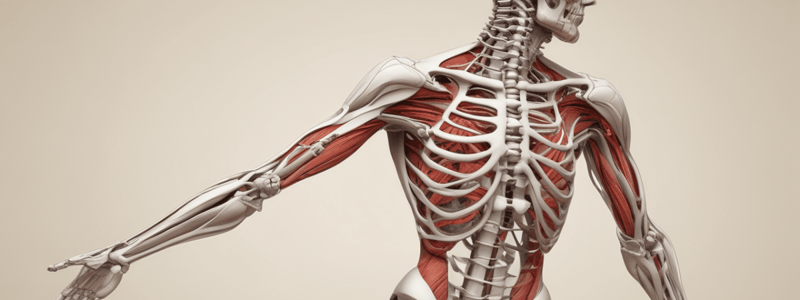Podcast
Questions and Answers
Match the type of joint with its characteristic movement:
Match the type of joint with its characteristic movement:
Condyloid Joints = Movement in two planes (flexion/extension, abduction/adduction) Pivot Joints = Movement in multiple planes (flexion/extension, abduction/adduction, rotation) Ball and Socket Joints = Rotation around a single axis Gliding Joints = Limited movement, usually in one plane
Match the type of joint with its example:
Match the type of joint with its example:
Condyloid Joints = Atlanto-axial joint (C1-C2) Pivot Joints = Wrist joint Ball and Socket Joints = Metacarpophalangeal joints Gliding Joints = Shoulder joint
Match the type of joint injury with its definition:
Match the type of joint injury with its definition:
Sprains = Bones are forced out of their normal position Strains = Overstretching or tearing of ligaments Dislocations = Overstretching or tearing of muscles or tendons Tendinitis = Not mentioned in the notes
Match the type of joint with its bone structure:
Match the type of joint with its bone structure:
Match the cause of joint injuries with its description:
Match the cause of joint injuries with its description:
Match the type of joint with its movement limitation:
Match the type of joint with its movement limitation:
Match the type of joint injury with its effect:
Match the type of joint injury with its effect:
Match the type of joint with its bone articulation:
Match the type of joint with its bone articulation:
Match the type of joint with its example location:
Match the type of joint with its example location:
What is the primary energy source utilized by the Lactic Acid (LA) system to provide energy during high-intensity anaerobic activities?
What is the primary energy source utilized by the Lactic Acid (LA) system to provide energy during high-intensity anaerobic activities?
What is the duration of the LA system during high-intensity anaerobic activities if the exercise is performed at maximum intensity?
What is the duration of the LA system during high-intensity anaerobic activities if the exercise is performed at maximum intensity?
What is the main limitation of the LA system during anaerobic activities?
What is the main limitation of the LA system during anaerobic activities?
What is the percentage of potential energy freed by the LA system during anaerobic activities?
What is the percentage of potential energy freed by the LA system during anaerobic activities?
What is the duration of the LA system during anaerobic activities if the intensity is lowered?
What is the duration of the LA system during anaerobic activities if the intensity is lowered?
What is the advantage of the LA system in terms of ATP resynthesis?
What is the advantage of the LA system in terms of ATP resynthesis?
What is the characteristic of the LA system that makes it readily accessible?
What is the characteristic of the LA system that makes it readily accessible?
What type of sports activities primarily utilize the LA energy system?
What type of sports activities primarily utilize the LA energy system?
Flashcards are hidden until you start studying
Study Notes
Joints in Physical Education
Types of Joints
Condyloid Joints
- Also known as ellipsoidal joints
- Two bones articulate with each other, allowing for movement in two planes (flexion/extension, abduction/adduction)
- Examples: wrist joint, metacarpophalangeal joints
Pivot Joints
- One bone rotates within a ring formed by another bone
- Movement is limited to rotation around a single axis
- Examples: atlanto-axial joint (C1-C2), proximal radioulnar joint
Ball and Socket Joints
- One bone has a rounded head that fits into a cup-like depression in another bone
- Movement occurs in multiple planes (flexion/extension, abduction/adduction, rotation)
- Examples: shoulder joint, hip joint
Joint Injuries
- Common types of joint injuries:
- Sprains: overstretching or tearing of ligaments
- Strains: overstretching or tearing of muscles or tendons
- Dislocations: bones are forced out of their normal position
- Causes of joint injuries:
- Overuse or repetitive stress
- Sudden, forceful movements
- Poor technique or biomechanics
- Insufficient warm-up or cool-down
Gliding Joints
- Two flat bone surfaces slide past each other
- Limited movement, usually in one plane
- Examples: joints between tarsal bones in the foot, joints between carpal bones in the wrist
Note: These notes provide an overview of the different types of joints, their characteristics, and examples of each. Additionally, they touch on joint injuries, including common types and causes, and briefly cover gliding joints.
Studying That Suits You
Use AI to generate personalized quizzes and flashcards to suit your learning preferences.




